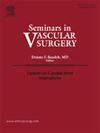Digital twin and artificial intelligence technologies for predictive planning of endovascular procedures
Abstract
Current planning of aortic and peripheral endovascular procedures is based largely on manual measurements performed from the 3-dimensional reconstruction of preoperative computed tomography scans. Assessment of device behavior inside patient anatomy is often difficult, and available tools, such as 3-dimensional–printed models, have several limitations. Digital twin (DT) technology has been used successfully in automotive and aerospace industries and applied recently to endovascular aortic aneurysm repair. Artificial intelligence allows the treatment of large amounts of data, and its use in medicine is increasing rapidly. The aim of this review was to present the current status of DTs combined with artificial intelligence for planning endovascular procedures. Patient-specific DTs of the aorta are generated from preoperative computed tomography and integrate aorta mechanical properties using finite element analysis. The same methodology is used to generate 3-dimensional models of aortic stent-grafts and simulate their deployment. Post processing of DT models is then performed to generate multiple parameters related to stent-graft oversizing and apposition. Machine learning algorithms allow parameters to be computed into a synthetic index to predict Type 1A endoleak risk. Other planning and sizing applications include custom-made fenestrated and branched stent-grafts for complex aneurysms. DT technology is also being investigated for planning peripheral endovascular procedures, such as carotid artery stenting. DT provides detailed information on endovascular device behavior. Analysis of DT-derived parameters with machine learning algorithms may improve accuracy in predicting complications, such as Type 1A endoleaks.

 求助内容:
求助内容: 应助结果提醒方式:
应助结果提醒方式:


